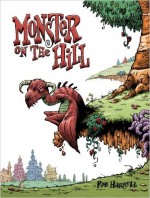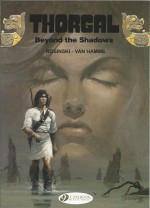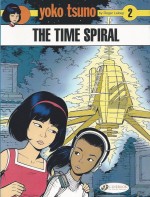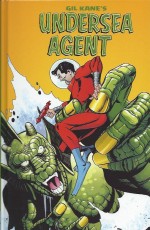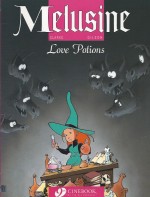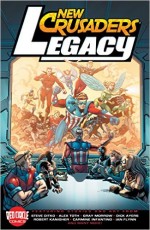
By Rich Buckler, Ian Flynn, Robert Kanigher, Stan Timmons, Alex Toth, Carmine Infantino, Steve Ditko, Dick Ayers, Gray Morrow, Alec Niño, Tony DeZuñiga, Jerry Gaylord, Ben Bates, Alitha Martinez & many more (Red Circle/Archie Comics)
ISBN: 978-1-936975-22-8
In the dawning days of the comic book business, just after Superman and Batman began creating a new genre of storytelling, many publishers jumped onto the bandwagon and made their own bids for cash and glory. Many thrived and many more didn’t; now relished only as trivia by sad old blokes like me. Some few made it to an amorphous middle-ground: not forgotten, but certainly not household names either…
MLJ were one of the quickest publishers to jump on the Mystery-Man bandwagon, following the spectacular successes of the Man of Tomorrow with their own small yet inspirational pantheon of gaudily clad costumed crusaders, beginning in November 1939 with Blue Ribbon Comics. Soon followed by Top-Notch and Pep Comics, their content was the standard blend of two-fisted adventure strips, prose pieces and gag panels and, from #2 on, superheroes…
However, after only a few years Maurice Coyne, Louis Silberkleit and John Goldwater spotted a gap in the blossoming market and in December 1941 nudged aside their masked heroes and action strips to make room for a far less imposing hero; an “average teen†who would have ordinary adventures like the readers, but with triumphs, romance and slapstick emphasised.
Pep Comics #22 featured a gap-toothed, freckle-faced, red-headed goof who clearly took his lead from Mickey Rooney’s popular Andy Hardy matinee movies. Goldwater developed the concept of a youthful everyman protagonist, tasking writer Vic Bloom and artist Bob Montana with the job of making it work. A 6-page tale introduced Archie Andrews and pretty girl-next-door Betty Cooper as well as his unconventional best friend and confidante Jughead Jones in their small-town utopia of Riverdale.
The feature was an instant hit and by the winter of 1942 had won its own title. Archie Comics #1 was the company’s first solo-starring magazine and with it began the gradual transformation of the entire company. With the introduction of wealthy, raven-haired Veronica Lodge, all the pieces were in play for the comicbook industry’s second Genuine Phenomenon (Superman being the first)…
By 1946 the kids had taken over, so MLJ renamed itself Archie Comics; retiring its heroic characters years before the end of the Golden Age and becoming, to all intents and purposes, a publisher of family comedies. Its success, like Superman’s, changed the content of every other publisher’s titles, and led to a multi-media industry including TV shows, movies, a chain of restaurants and even a global pop hit “Sugar, Sugar†(a tune from their animated show).
Nonetheless, the company had by this stage blazed through a rather impressive pantheon of mystery-men who would form the backbone of numerous future superhero revivals, most notably in the High-Camp/Marvel Explosion/Batman TV show-frenzied mid-60’s era…
The heroes impressively resurfaced under the company’s Red Circle imprint during the early days of the Direct Sales revolution of the 1980s, but after a strong initial showing, again failed to sustain the public’s attention. Archie let them lie fallow (except for occasional revivals and intermittent guest-shots in Archie titles) until 1991, when the company licensed its heroes to superhero specialists DC for a magically fun, all-ages iteration (and where’s that star-studded trade paperback collection, huh?!). Impact Comics was a vibrant, engaging and fun all-ages rethink that really should have been a huge hit but was again cruelly unsuccessful…
When the line folded in 1993 the characters returned to limbo until DC had one more crack at them in 2008, attempting to incorporate the Mighty Crusaders & Co into their own maturely angst-ridden and stridently dark continuity – with the usual overwhelming lack of success.
Recently the wanderers returned home to Archie for a superbly simplistic and winningly straightforward revival aimed squarely at old nostalgics and young kids reared on highly charged action/adventure cartoon shows: brimming with all the exuberant verve and wide-eyed honest ingenuity you’d expect from an outfit which has been pleasing kids for nearly seventy years.
Released initially online in May 2012 – followed by a traditional monthly print version that September – the first story-arc made it to full legitimacy with a thrill-packed trade paperback collection, equally welcoming to inveterate fanboys and eager newcomers alike.
The series introduced a new generation of legacy heroes rising from the ashes of their parents’ and guardians’ murders to become a team of teenaged gladiators carrying on the fight as the New Crusaders.
This collection supplements and follows on from that magical makeover: having new team mentor The Shield train the potential-filled juniors through the records of their predecessors. The stories included here come from those aforementioned 1980s Red Circle episodes; culled from the pages of Mighty Crusaders #1, 8, 9, The Fly #2, 4, 6, Blue Ribbon #3, 8, 14, The Comet #1 and Black Hood #2, spanning 1983-1985…
Following an engaging reintroduction and recap, current creative team Ian Flynn, Jerry Gaylord, Ben Bates & Alitha Martinez reveal how the grizzled, flag-draped veteran has trouble reaching his teenaged students until he begins treating them as individuals, and sharing past Crusaders’ cases.
Starting with personal recollections of his own early days as America’s first Patriotic superhero in ‘The Shield’ (from Mighty Crusaders #8, Marty Greim, Dick Ayers & Rich Buckler), Joe Higgins explains his active presence in the 21st century, leading into a recapitulation of the first Red Circle yarn.
‘Atlantis Rising’ comes from Mighty Crusaders #1, by Buckler & Frank Giacoia, which found psionic plunderer Brain Emperor and immortal antediluvian Eterno the Conqueror launching a multi-pronged attack on the world. They were countered by an army of costumed champions including the Golden Age Shield, Lancelot Strong the (other) Shield (for a while there were three different ones active at once), Fly and Fly-Girl, Jaguar, The Web, Black Hood and The Comet, who communally countered a global crime-wave and clobbered the villains’ giant killer robots…
This is followed by a modern interlude plus pin-up and data pages on Ralph Hardy AKA ‘The Jaguar’ before a potent vignette by Chas Ward & Carlos Vicatan from The Fly #4 reviews the animal-master’s Aztec origins and rebirth in ‘Renewal’…
‘The Web’ offers the same data-page update for masked detective and criminologist John Raymond before ‘The Killing Hour’ (Blue Ribbon #14, by Stan Timmons, Lou Manna, Rex Lindsey & Chic Stone) sees the merely mortal manhunter join his brother-in-law the Jaguar in foiling a nuclear terrorism plot…
More modern pin-ups and data-pages reintroduce ‘The Comet’ before Bill DuBay, Jr., Carmine Infantino & Alec Niño reworked the original 1940’s origin tale by Jack Cole from Pep Comics #1 in 1940.
Reproduced from 1984’s The Comet #1, this chilling yarn detailed how an idealistic scientist became the most bloodthirsty hero of the Golden Age, with a body-count which made the Punisher look like a pantywaist…
The infomercial for ‘Steel Sterling’ precedes a wild and whimsical origin-retelling of the star-struck, super-strong “Man of Steel†by his 1940s scripter Robert Kanigher, illustrated with superb style by Louis Barreto & Tony DeZuñiga from Blue Ribbon #3, after which ‘Fly Girl’ gets star treatment in a brace of tales, augmented as always by the ubiquitous fact-folio.
‘A Woman’s Place’ by Buckler, Timmons, Adrian Gonzales & Ricardo Villagran (from The Fly #2) clears up an exceedingly sexist old-school extortion ring whilst ‘Faithfully Yours’ (Fly #6) saw her movie-star alter ego Kim Brand subjected to a chilling campaign of terror from a fan. Timmons, Buckler, Steve Ditko & Alan Kupperberg took just the right tone in what might be the first incidence of stalking in US comics…
‘Black Hood’ has no modern iteration in the New Crusaders. Still active in contemporary times, he did encounter the kids during their debut exploit and is phenomenally cool, so he gets a place here. Following the customary introductory lesson he appears in a gritty, Dirty Harry themed adventure (from Blue Ribbon #8 by Gray Morrow) as undercover cop – and latest convert – Kip Burland who sidesteps Due Process to save a kidnapped girl and ensure the conviction of crooks hiding behind the law. The gripping yarn also discloses the centuries-long justice-seeking tradition of “The Man of Mystery†…
That’s followed by a snippet from Rich Margopoulos, Kupperberg & Giacoia entitled ‘A Hero’s Rage’ wherein Kip discovers his uncle Matt (the Golden Age Black Hood) has been murdered and ditches his leather jacket and ski-mask in favour of the traditional costume before joining the Mighty Crusaders…
Without doubt the most engaging reprint in this collection and by itself well worth the price of admission is ‘The Fox’ from Black Hood #2. Written and drawn by the inimitable Alex Toth, this scintillating light-hearted period comedy-drama finds the devilish do-gooder in Morocco in 1948, embroiled with wealthy expatriate ex-boxer Cosmo Gilly who has no idea he’s become the target for assassination…
The recondite recollections surge to a climax with ‘Old Legends Never Die’ (Mighty Crusaders #9, by David M. Singer, Buckler & Ayers) as the first Shield is accused of excessive force and manslaughter when his 1940’s crime-fighting style seemingly results in the death of a thief he most forcefully apprehended. With Joe Higgins’ costumed friends in support but out of their depth in a courtroom, the convoluted history of the three heroes bearing his codename are unpicked during ‘The Trial of the Shield’ before the uncannily sinister truth is finally exposed…
Supplemented by a plentiful cover gallery and packed with the kind of ephemera that sends old Fights ‘n’ Tights fans into paroxysms of delight, I fear this is probably a book only the wide-eyed young and dedicated aged nostalgists could handle, but it is such a perfect artefact of the superhero genre I strongly urge anyone with a hankering for masked adventure and craving Costumed Dramas to give it a long look.
NEW CRUSADERS and RED CIRCLE COMICS ® ACP, Inc. © 2013 Archie Comics Publications. All rights reserved.

